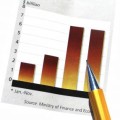This is the VOA Special English Economics Report.
Economics and weather have a lot in common. Knowing what conditions will be like weeks or months in the future is not easy. One thing that helps economists predict the future is the index of leading economic indicators.
An index is a way to measure changes in a group of numbers over time. In financial markets, for example, an index of stocks will rise or fall with changes in the wider market. The changes measured by an index can be represented with a single percentage.
The index may start at a base period of time with a value of one hundred. Now say that a month later the value is recorded as one hundred one. That means it gained one percent. If the index lost one percent, however, the value would be ninety-nine.
The leading economic indicators are really ten indexes. Four deal with manufacturing activity. One deals with unemployment claims. Another measures people's expectations of the economy. Still others involve financial information like the money supply and interest rates.
The index of leading indicators is just one of the tools used to measure the business cycle. Business cycles are the normal changes that happen in economic growth over time.
A measure called the coincident index provides information about current conditions. Employment rates are an important part of it. There is also a lagging index. It helps confirm economic changes that currently appear to be taking place. Interest rates are an important lagging indicator.
The Conference Board publishes economic indicators for the United States. The Conference Board is a non-profit organization based in New York. It brings together business leaders to learn new ideas from one another. It has member companies around the world.
The Conference Board also does economic research. Its work helps show business and government leaders what conditions might be ahead.
But this group did not always produce the index of leading economic indicators. It took over the job in nineteen ninety-five from the Bureau of Economic Analysis, part of the Commerce Department.
The Conference Board also publishes economic indicators for Australia, France, Germany and Japan. Others are Britain, Mexico, South Korea and Spain.
And that's the VOA Special English Economics Report, written by Mario Ritter. Read and listen to our reports at voaspecialenglish.com. I'm Steve Ember.

